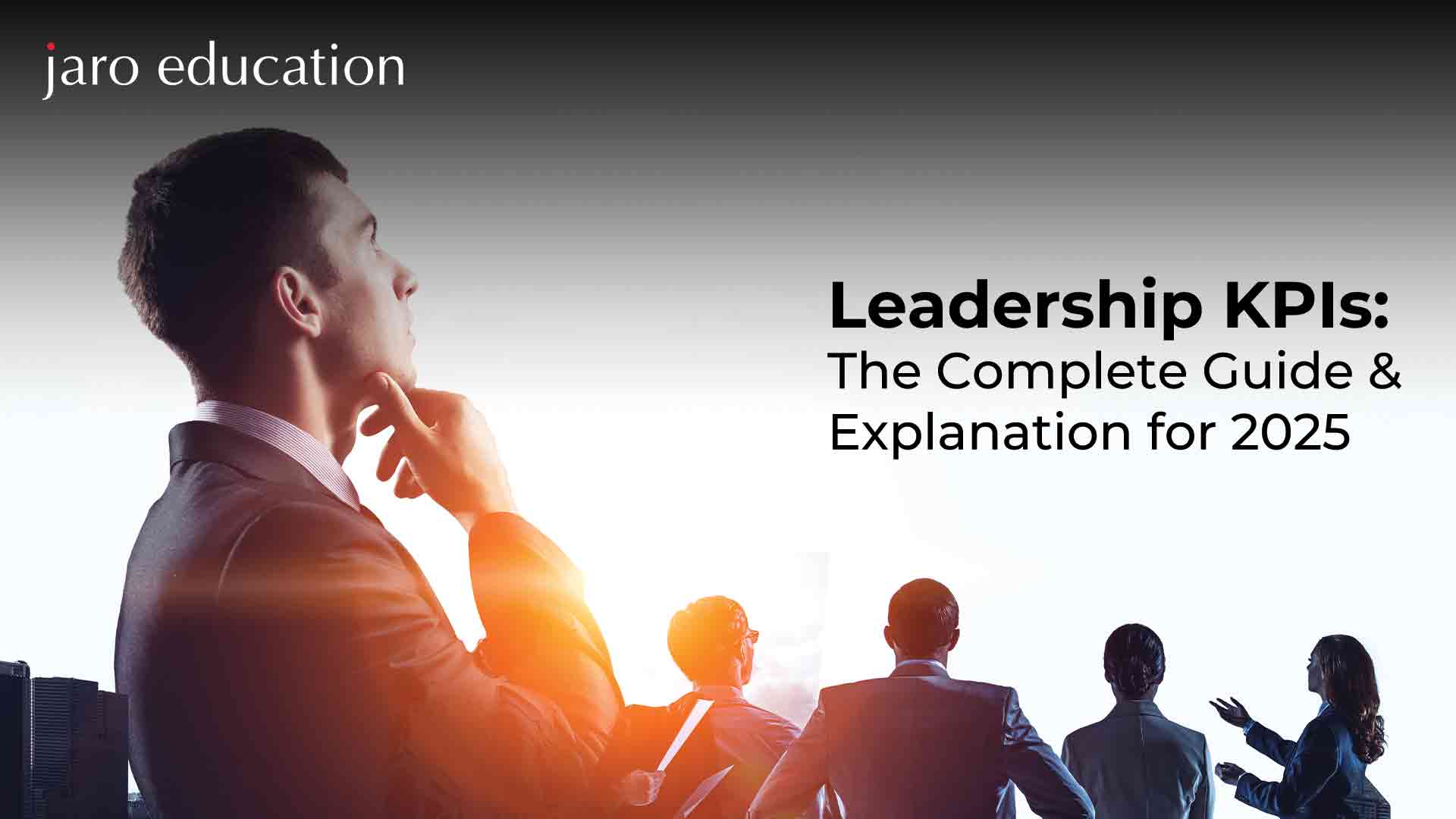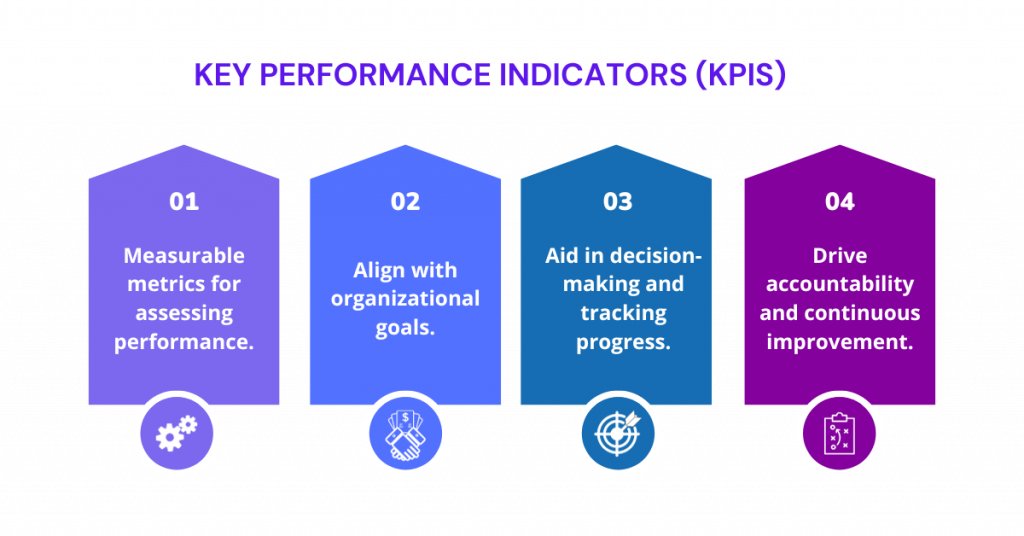Leadership KPIs: The Complete Guide & Explanation for 2025
Table of Contents

- jaro education
- 27, October 2024
- 11:00 am
Leadership effectiveness has always been a cornerstone of business success, but as we head into 2025, the metrics used to evaluate leadership have shifted significantly. With the rise of hybrid work models, evolving employee expectations, and rapid digital transformation, leaders need to be more adaptable, empathetic, and data-driven than ever before. This emphasizes the need for a clear explanation of leadership Key Performance Indicators not to be missed in 2025.
Key Performance Indicators (KPIs) serve as invaluable tools in this context, offering clear, measurable data to assess the effectiveness of leaders at various levels. From boosting employee engagement to fostering innovation, the right leadership KPIs can provide insights into how well a leader is guiding their team, department, or organization. More importantly, leadership KPIs can highlight areas for improvement, helping leaders refine their strategies and continuously improve their impact.
In this guide, we’ll explore the leadership KPIs that matter most in 2025, delving into both team-based and self-development metrics. We’ll also look at how leadership development programmes can aid in achieving these leadership KPIs, with a special focus on professional programmes offered by Jaro Education and partner institutions.
Why Leadership KPIs Matter More Than Ever
In today’s fast-paced and dynamic corporate world, leadership is more critical than ever. Yet, simply occupying a leadership role is not enough; measurable success is key. Leaders must not only inspire and guide their teams but also drive performance and innovation. The use of leadership KPIs allows organizations to quantify these outcomes and assess leadership effectiveness in a structured way.
Leadership KPIs are more than just metrics—they’re a reflection of how well a leader aligns their team’s actions with organizational goals, how effectively they engage and retain talent, and how well they adapt to market changes. For example, a good leader is expected to improve team morale, foster a positive workplace culture, and maintain high retention rates. However, how can an organization definitively know if a leader is excelling in these areas?
This is where leadership KPIs come into play. The right leadership KPIs help leaders focus on outcomes that truly matter, avoid distractions, and hone in on strategies that enhance performance. As businesses evolve, the importance of selecting appropriate leadership KPIs has become even more pressing. With the impact of hybrid work environments, technological advancements, and the growing importance of diversity and inclusion, the landscape has changed—so too must the way leadership is measured.

*ChiselLabs
Top Leadership KPIs for 2025
As we enter 2025, businesses are facing new challenges and opportunities. This calls for leadership Key Performance Indicators not to be missed in 2025 that reflect the current environment, emphasizing not only traditional metrics like team performance but also softer, more nuanced aspects of leadership like emotional intelligence, adaptability, and digital literacy.
Leadership KPIs for Team Leadership
| Leadership KPIs | Description | 2025 Target |
|---|---|---|
| Employee Retention Rate | Percentage of employees who stay with the company over a specified period | 85-90% retention rate |
| Employee Engagement Score | Measures employee enthusiasm and commitment to the organization | Target score of 80-85% |
| Customer Satisfaction (CSAT) | Gauges how satisfied customers are with the team’s products or services | Average score of 85% |
| Team Productivity | The overall output or results achieved by the team in a given timeframe | Target 95% project completion rate |
| Innovation Index | Measures the team's ability to innovate and introduce new ideas | 70-80% engagement in innovation |
1. Employee Retention Rate
Employee retention remains one of the most telling indicators of a leader’s success. High employee turnover is often a sign of poor leadership, whether due to a toxic work environment, lack of career growth opportunities, or disengagement.
- Why it matters in 2025: Retaining top talent is crucial in an era where skilled professionals are highly mobile and have a wealth of options. Leaders who create an engaging, supportive environment will naturally retain talent, reducing costs associated with hiring and training new employees.
- Example: A tech company can set a KPI to retain at least 90% of its top performers, ensuring consistency in innovation and project continuity.
2. Employee Engagement Score
Employee engagement refers to how connected and committed employees are to their work and the organization’s goals. Leaders who foster high engagement tend to see better productivity and lower absenteeism.
- Why it matters in 2025: As remote and hybrid work models become more common, keeping employees engaged when they aren’t physically present becomes a key leadership challenge. Leadership KPIs for team leaders focused on engagement ensure that leaders are taking steps to build a cohesive team culture, even across geographical boundaries.
3. Diversity and Inclusion Index
Diversity and inclusion are no longer just buzzwords—they are critical to organizational success. Leadership KPIs focused on diversity measures how well a leader fosters an inclusive environment where employees from various backgrounds can thrive.
- Why it matters in 2025: A diverse team brings diverse ideas, perspectives, and innovation. Leaders who prioritize inclusivity are often more successful in leading teams that are agile and adaptable in the face of change.
4. Customer Satisfaction (CSAT)
Customer satisfaction is a key metric for leaders overseeing customer-facing teams. It provides a direct reflection of how well a leader’s team meets or exceeds customer expectations.
- Why it matters in 2025: Customer expectations are higher than ever, with technology enabling greater transparency and personalization. Leaders who can keep their teams focused on delivering exceptional service will be critical to maintaining customer loyalty.
5. Team Productivity
Productivity leadership KPIs help leaders measure the output of their teams. Whether this involves meeting project deadlines or achieving sales targets, productivity metrics provide an objective assessment of a team’s efficiency.
- Why it matters in 2025: With teams working remotely or in hybrid environments, maintaining productivity requires new strategies and tools. Leaders must ensure that teams remain focused and productive, regardless of where they work.
6. Innovation Index
Innovation is the lifeblood of competitive organizations. An innovation index measures how often teams introduce new ideas, improve processes, or create new products.
- Why it matters in 2025: In an era where technological disruption is constant, fostering a culture of innovation is key. Leaders who can measure and promote innovation within their teams will drive long-term success.
KPIs for Personal Leadership Development
Beyond managing teams, leaders must also focus on their own growth. Developing leadership capabilities is a continuous process, and setting personal leadership KPIs can help leaders track their progress.
| Leadership KPIs | Description | 2025 Target |
|---|---|---|
| Learning and Development Hours | Hours spent on leadership training, courses, and self-improvement | 50+ hours annually |
| 360-Degree Feedback Score | Feedback from peers, subordinates, and superiors on leadership style | 85% or higher positive feedback |
| Adaptability Score | Measures a leader’s ability to adapt to change | Demonstrates agility in 90% of situations |
| Emotional Intelligence (EI) | Gauges a leader’s self-awareness, empathy, and interpersonal skills | Target a high EI score in assessments |
| Decision-Making Speed | Measures the average time taken to make key decisions | 20% reduction in decision-making time |
1. Learning and Development Hours
Leaders must commit to continuous learning, whether through formal education, attending workshops, or engaging with new thought leadership.
- Why it matters in 2025: The business world is constantly evolving, and leaders who remain stagnant risk falling behind. Committing to ongoing learning ensures that leaders stay current on best practices, new technologies, and emerging industry trends.
2. 360-Degree Feedback Score
One of the best ways to measure leadership effectiveness is through 360-degree feedback. This allows leaders to receive feedback from multiple sources, offering a comprehensive view of their leadership abilities.
- Why it matters in 2025: With diverse teams working across various platforms, it’s important for leaders to understand how their actions are perceived by those they manage, as well as their peers and supervisors.
3. Adaptability Score
The ability to adapt quickly to changing circumstances is a crucial leadership trait, especially in today’s fast-paced, technology-driven environment. Leaders who are slow to adapt can inadvertently hold back their teams or organizations.
4. Emotional Intelligence (EI)
Emotional Intelligence (EI) is increasingly seen as a defining trait of effective leadership. Leaders with high EI tend to manage conflict better, build stronger teams, and foster a more positive work culture.

*Investopedia
Adapting Leadership KPIs to the Changing Business Landscape
- Digital Transformation: As more business processes become automated, leadership KPIs related to digital literacy, tech adoption, and AI integration are becoming critical for leaders.
- Remote Leadership: Managing remote teams requires a different skill set than managing in-office teams. Leadership KPIs must reflect how well leaders can maintain productivity and engagement from afar.
- Sustainability and Social Responsibility: There’s growing pressure on leaders to prioritize sustainability and corporate social responsibility. KPIs that measure the impact of leadership on these areas are gaining prominence.
How Leadership Programmes Develop KPI-Based Competencies
Professional development programmes play a vital role in helping leaders develop the skills needed to meet KPI targets. Institutions like Jaro Education, in partnership with renowned business schools like IIM Ahmedabad and IIM Kozhikode, offer leadership programmes designed to build key competencies in strategic thinking, emotional intelligence, and adaptability.
| Course Name | Institute | Key Focus Areas |
|---|---|---|
| Post Graduate Certificate in Senior Management Programme | IIM Tiruchirappalli | Advanced management insights for senior leaders |
| New Age Management Programme for Senior Professionals | IIM Kozhikode | Leadership capabilities for senior executives |
| Accelerated General Management Programme | IIM Ahmedabad | Strategic thinking and general management |
| Post Graduate Certificate Programme in General Management | IIM Nagpur | Versatile management skills applicable across industries |
| Professional Certificate Programme in Strategic Management | IIM Kozhikode | Decision-making and long-term strategic planning |
Takeaway: Building Leadership for the Future
In 2025, the most successful leaders will be those who can adapt to new challenges, foster innovation, and maintain high levels of engagement across their teams. By setting and tracking the right leadership KPIs, leaders can ensure they’re meeting both their personal goals and the needs of their organization.
This comprehensive guide provides a roadmap for using leadership KPIs effectively in 2025. Whether you’re leading a small team or overseeing a large organization, these KPIs will help ensure you’re driving success in the evolving business landscape.
H3
P
H4
P
Conclusion
P
Frequently Asked Questions
Key Performance Indicators (KPIs) for effective leadership are metrics used to evaluate a leader’s impact on organizational success. These include:
-
- Team Retention Rate: Measures how well a leader retains talented employees.
- Employee Engagement (eNPS): Gauges how motivated and satisfied team members are.
- Training and Development: Tracks the investment and time dedicated to team learning.
- Project Success Rate: Measures how often a leader’s team successfully completes projects.
- Leadership Self-Development: Focuses on a leader’s commitment to personal growth and strategic thinking.
The key indicators of effective leadership include:
-
- Clear Vision and Strategy: A leader who sets a clear direction and communicates the goals effectively.
- Employee Engagement and Morale: High levels of team motivation and job satisfaction.
- Adaptability and Decision-Making: The ability to make informed decisions swiftly in changing environments.
- Team Development: Leaders who invest in upskilling and developing their team members.
- Results Orientation: Consistently delivering on goals and objectives.
The five commonly recognized KPIs for leadership include:
-
- Employee Retention: Percentage of team members retained over a set period.
- Team Productivity: Measures the output and efficiency of the team.
- Employee Engagement: Indicates how committed and motivated employees are.
- Customer Satisfaction: Reflects the team’s contribution to client or customer happiness.
- Financial Performance: Relates to how leadership contributes to revenue growth and profitability.
The 5 P’s of effective leadership, focusing on guiding principles, are:
-
- Purpose: Clear understanding of the organization’s mission and goals.
- People: Engaging and empowering team members to perform their best.
- Processes: Implementing efficient systems to achieve organizational objectives.
- Performance: Driving measurable results that align with business goals.
- Personal Development: Committing to continuous learning and self-improvement as a leader.










